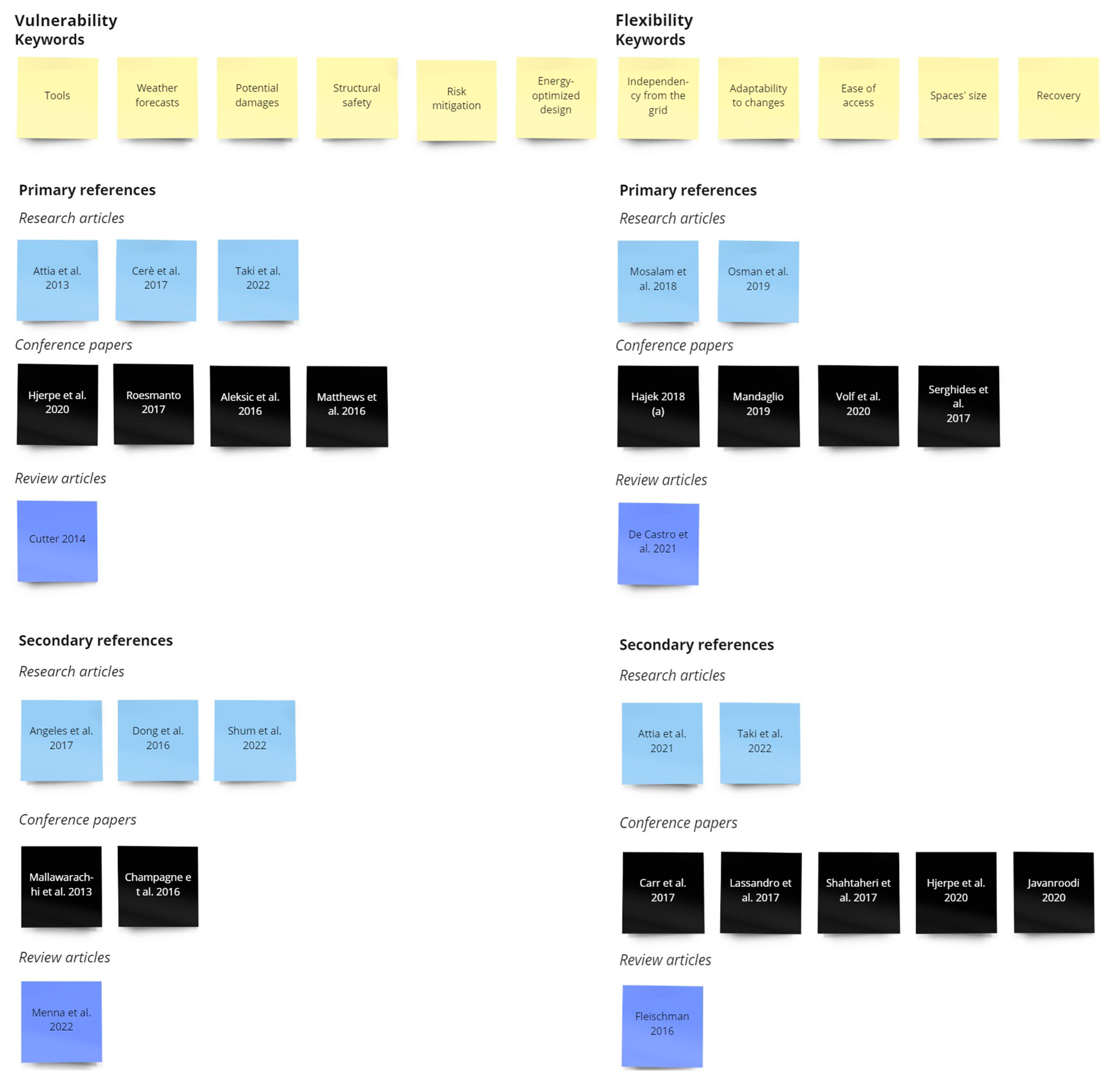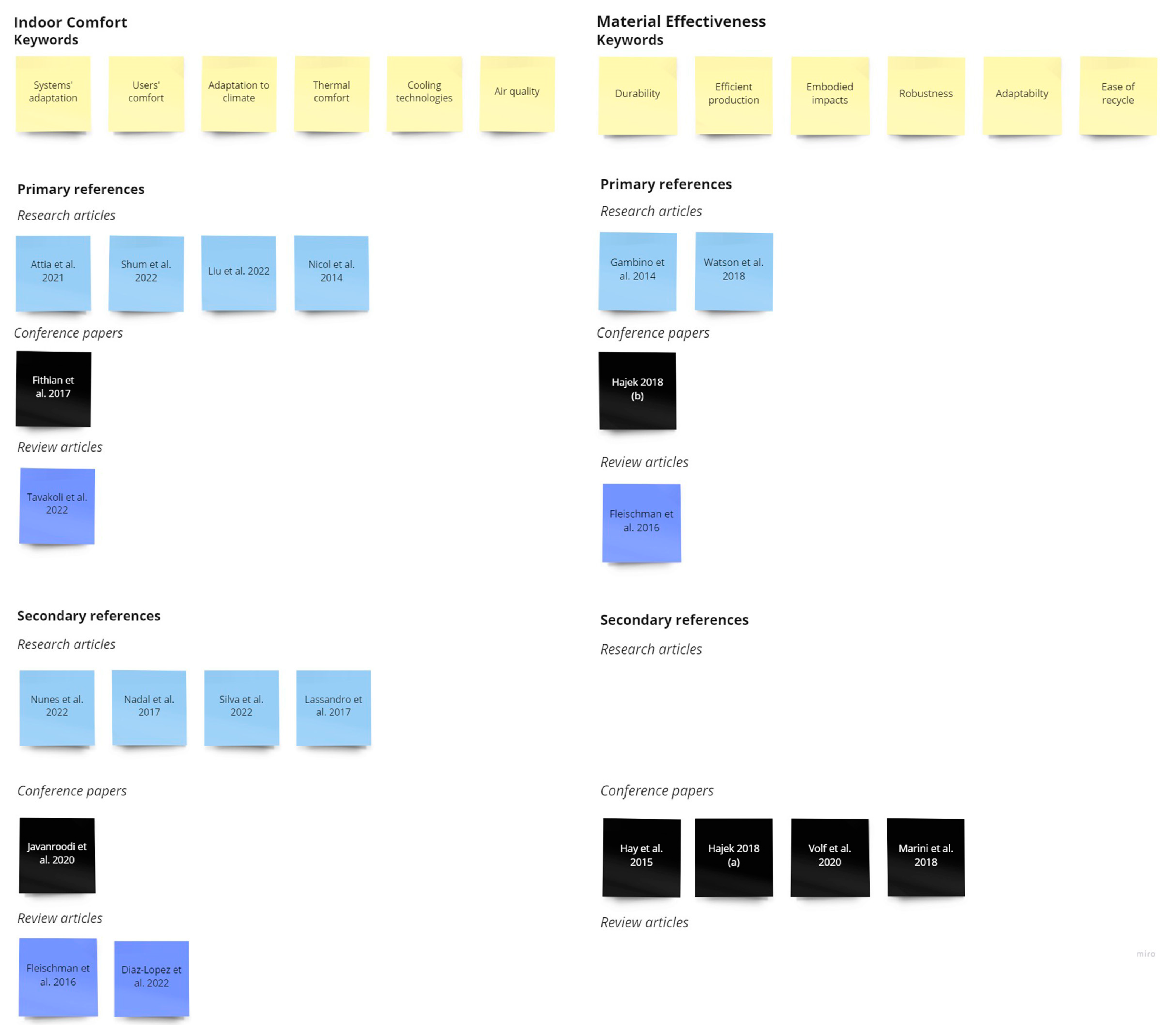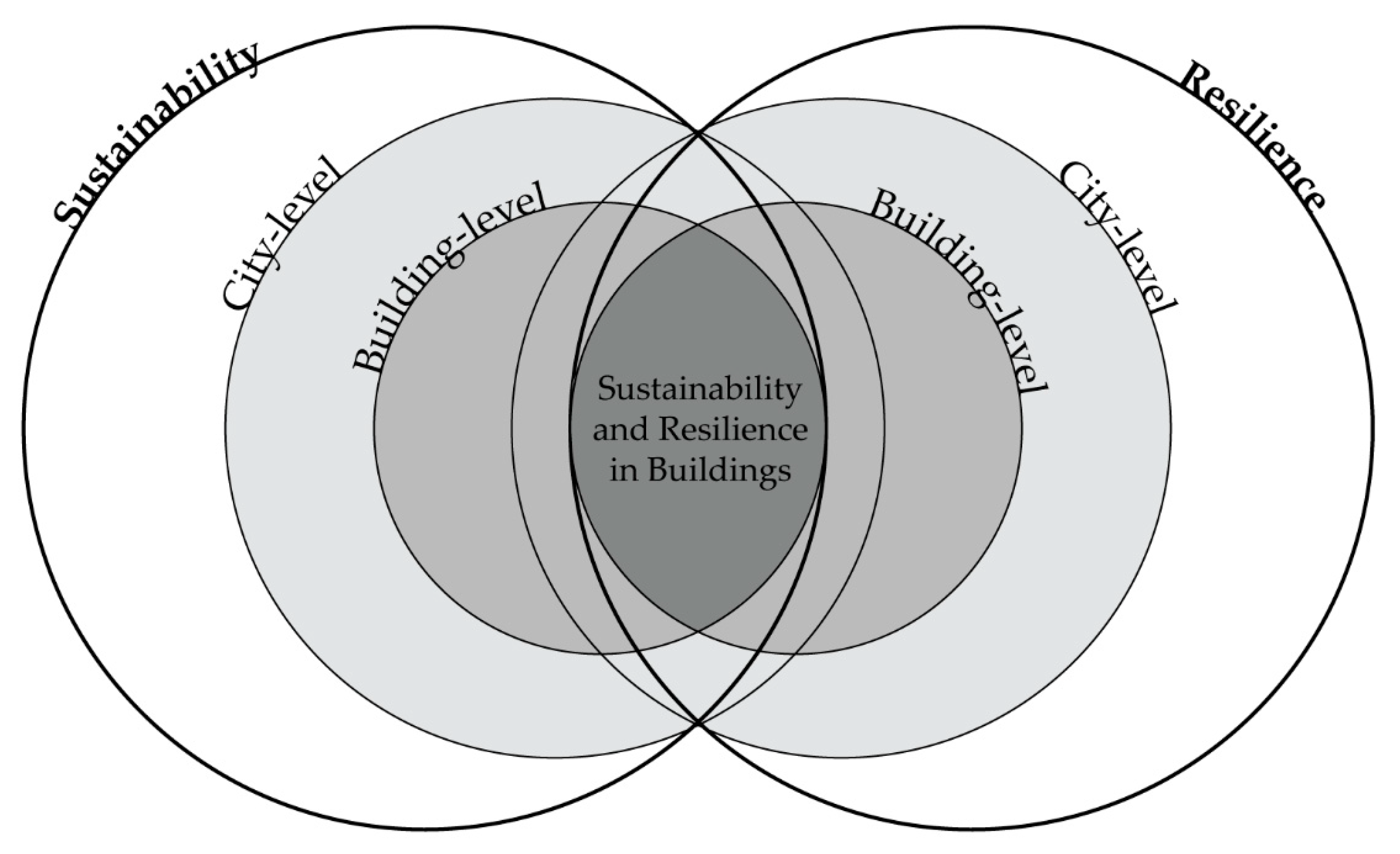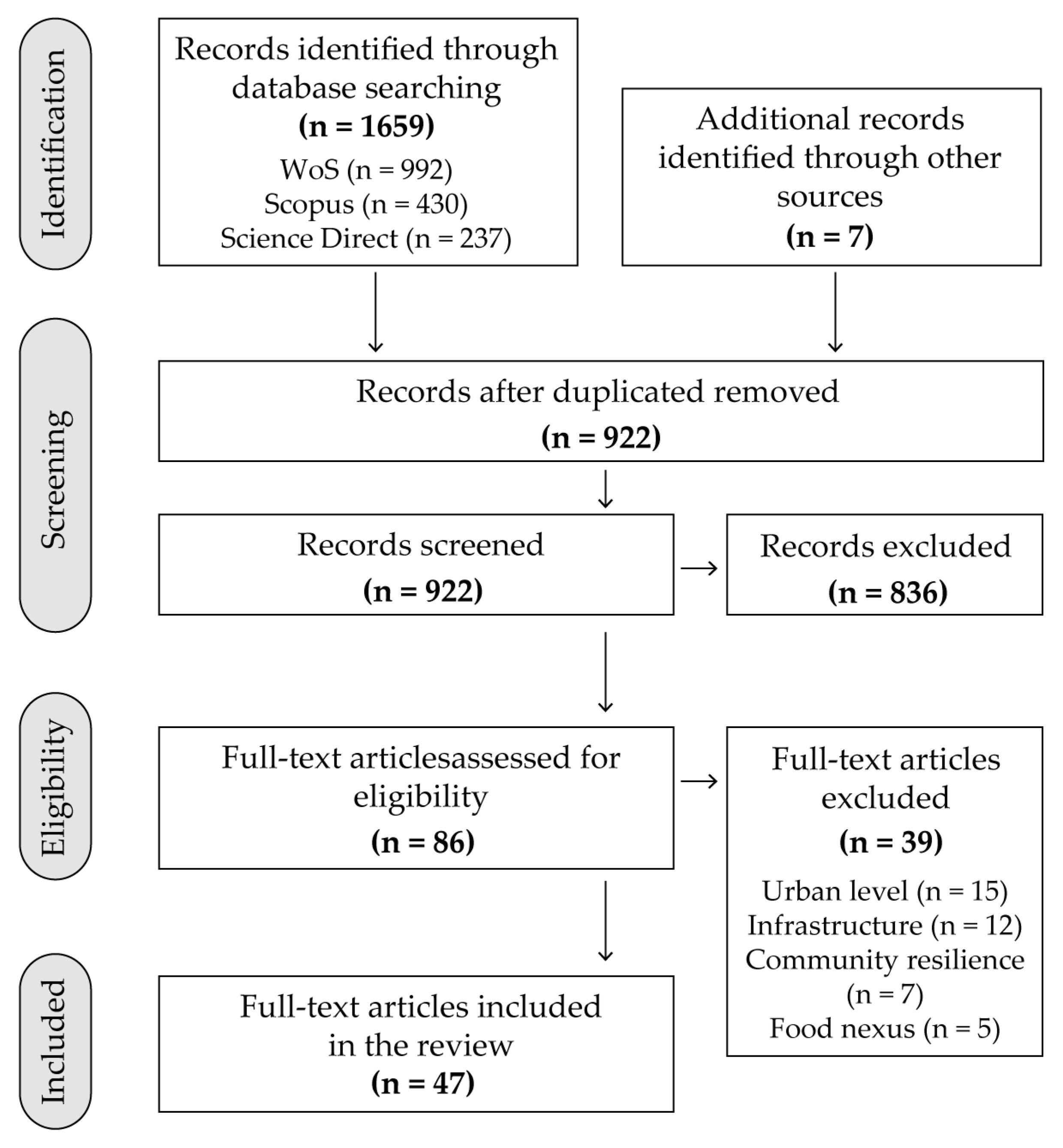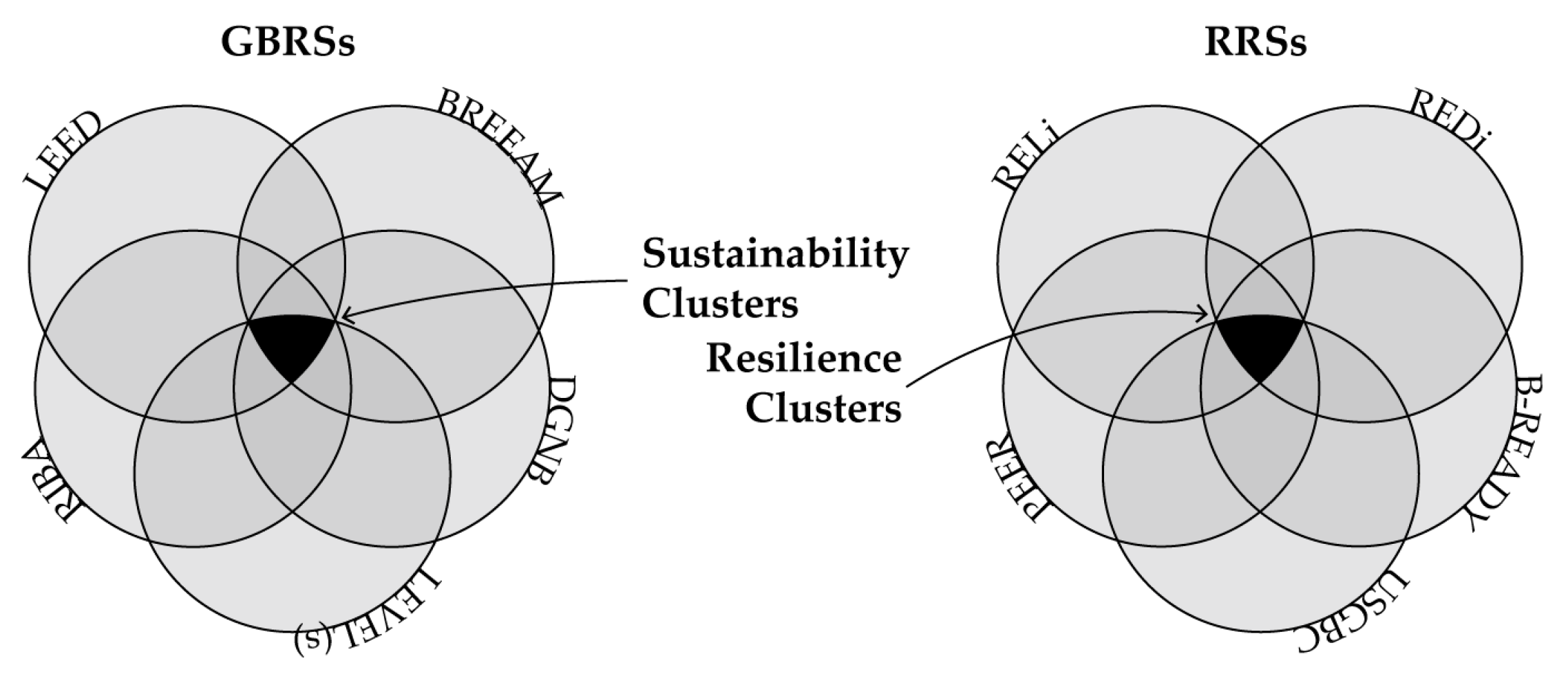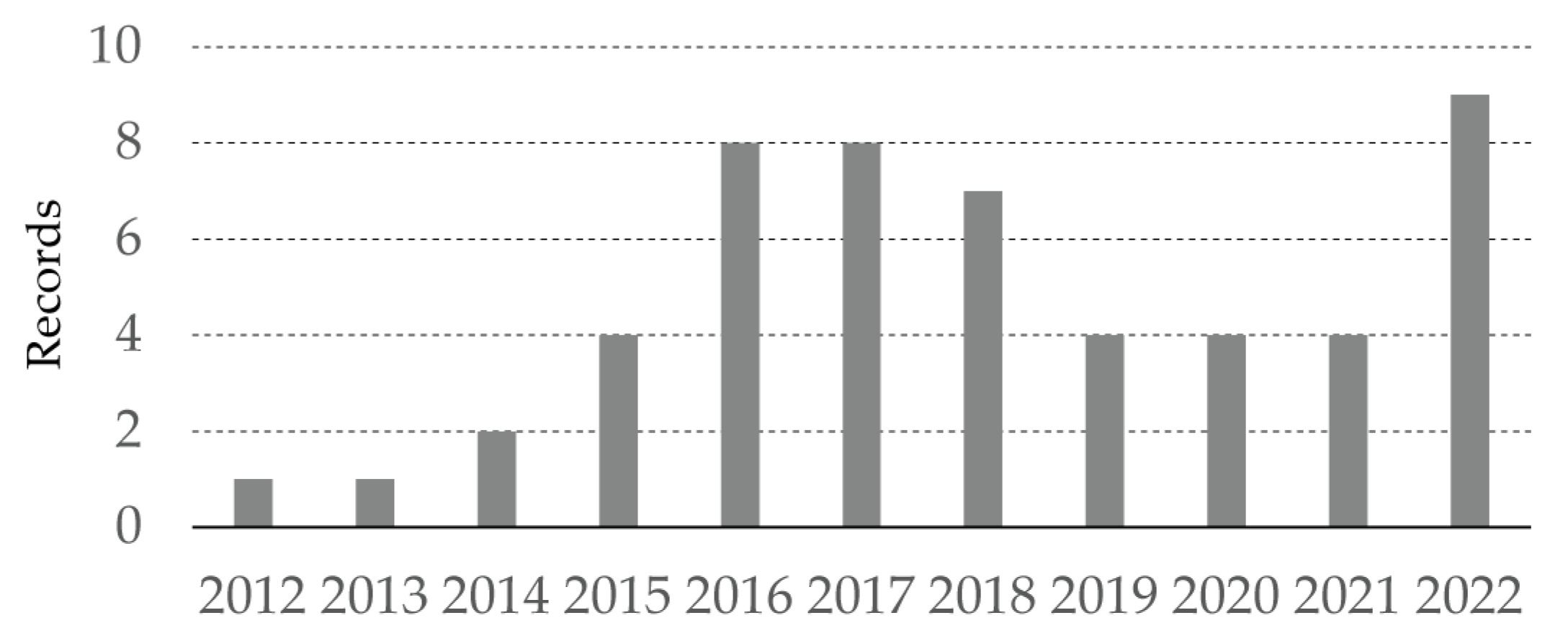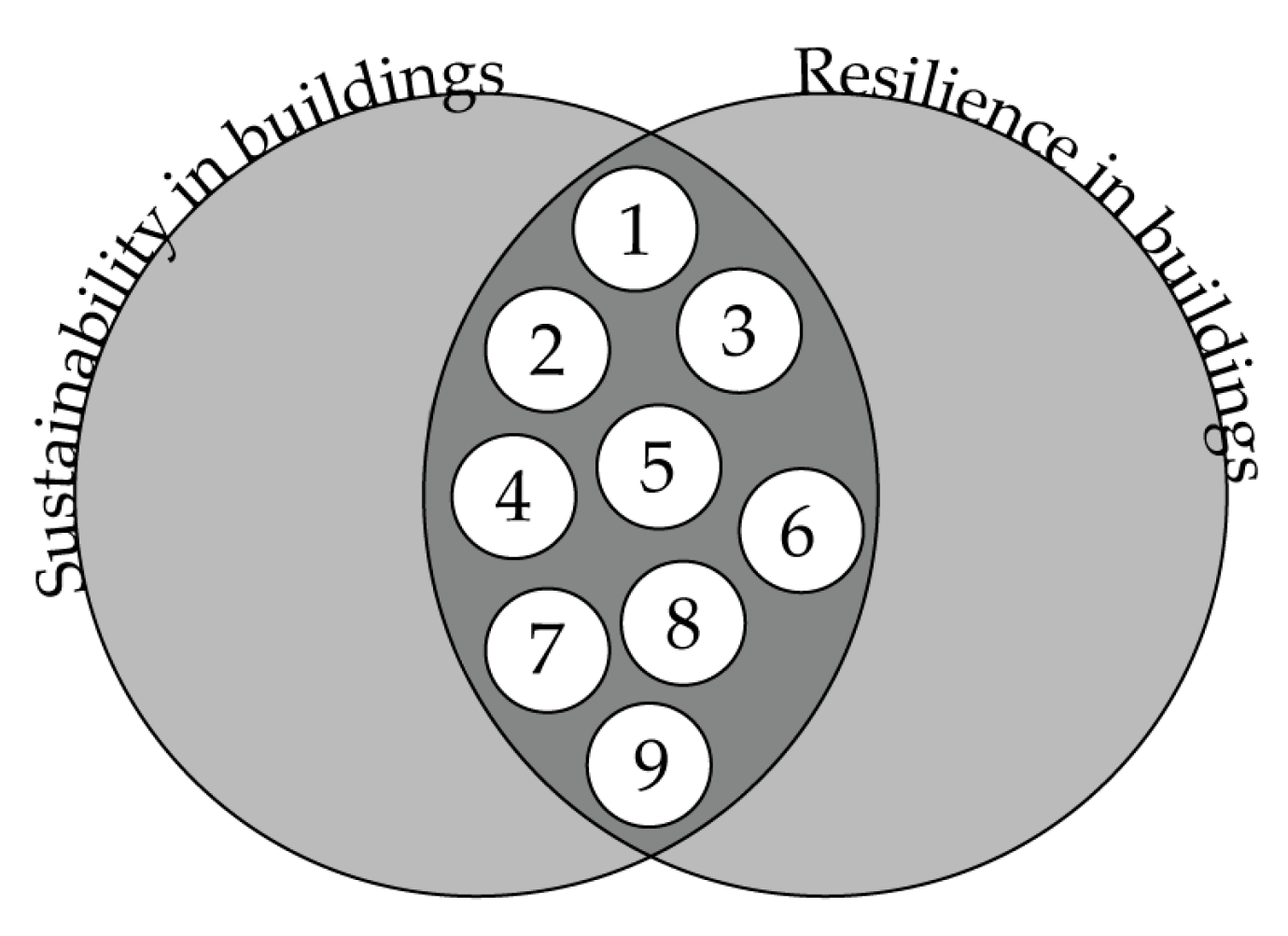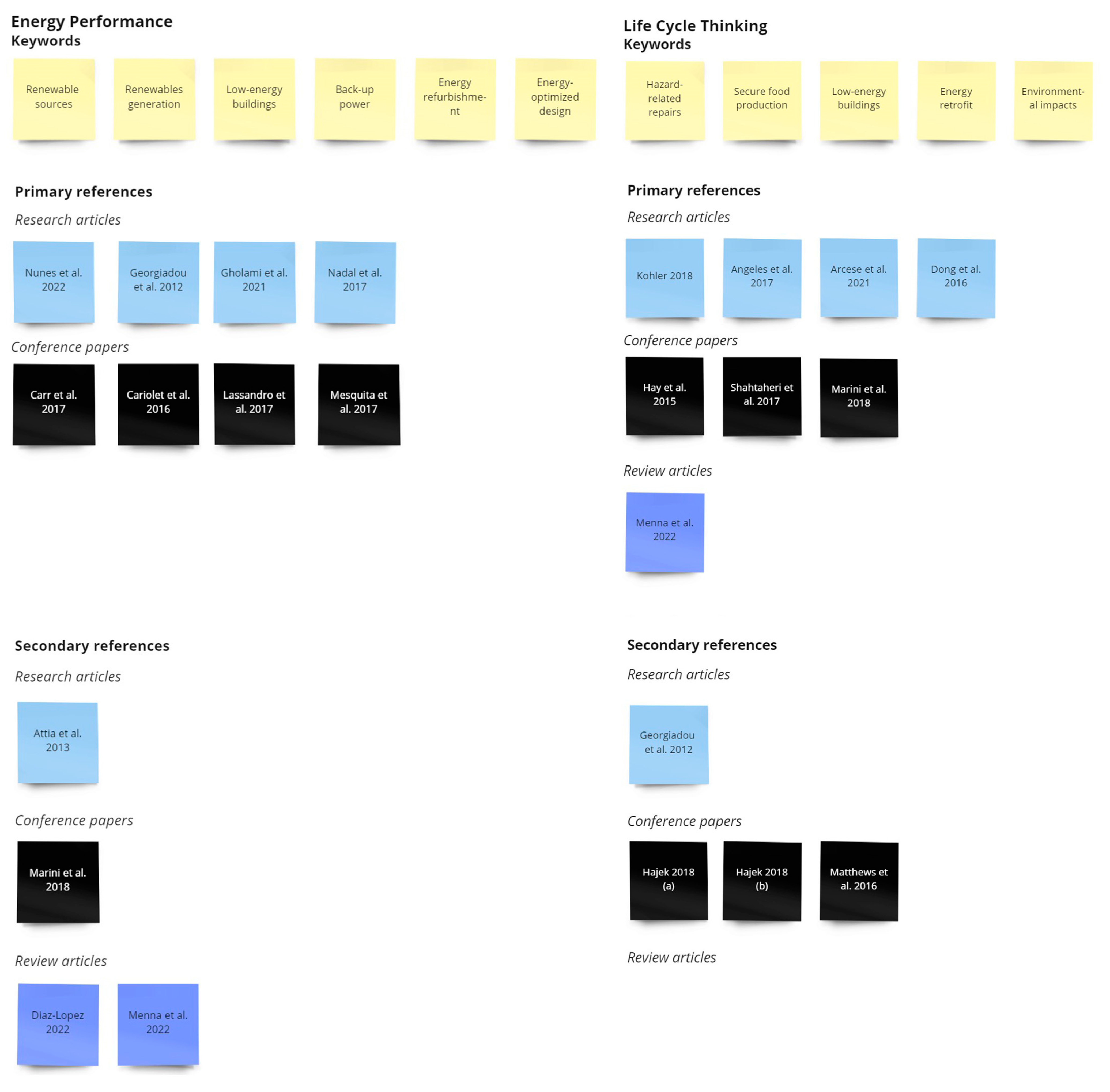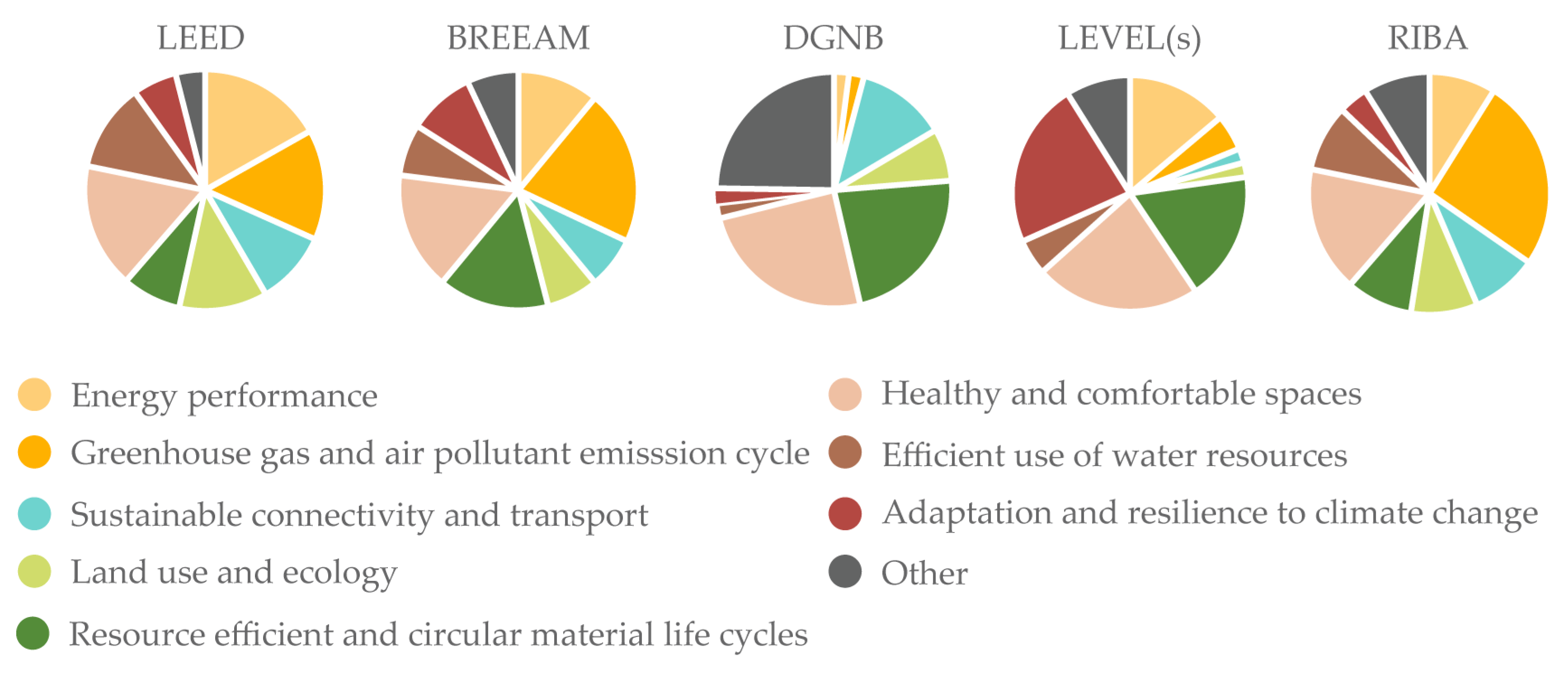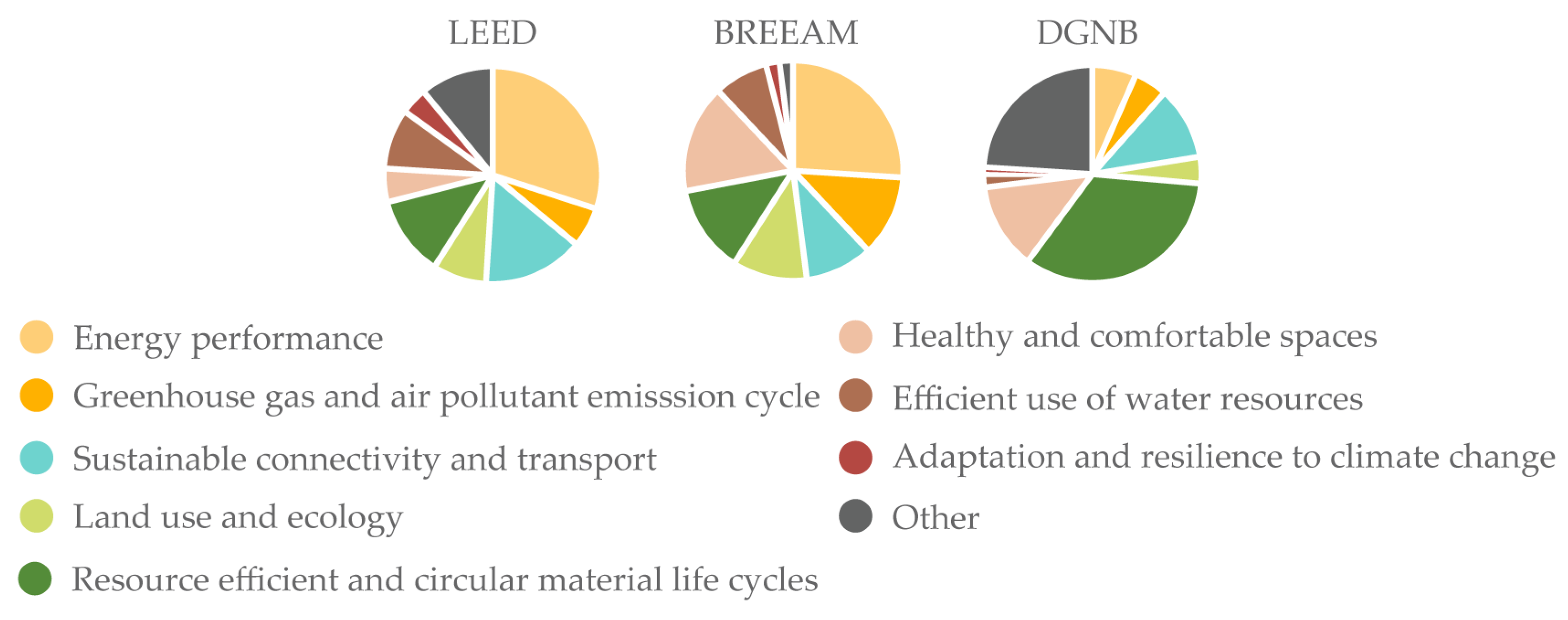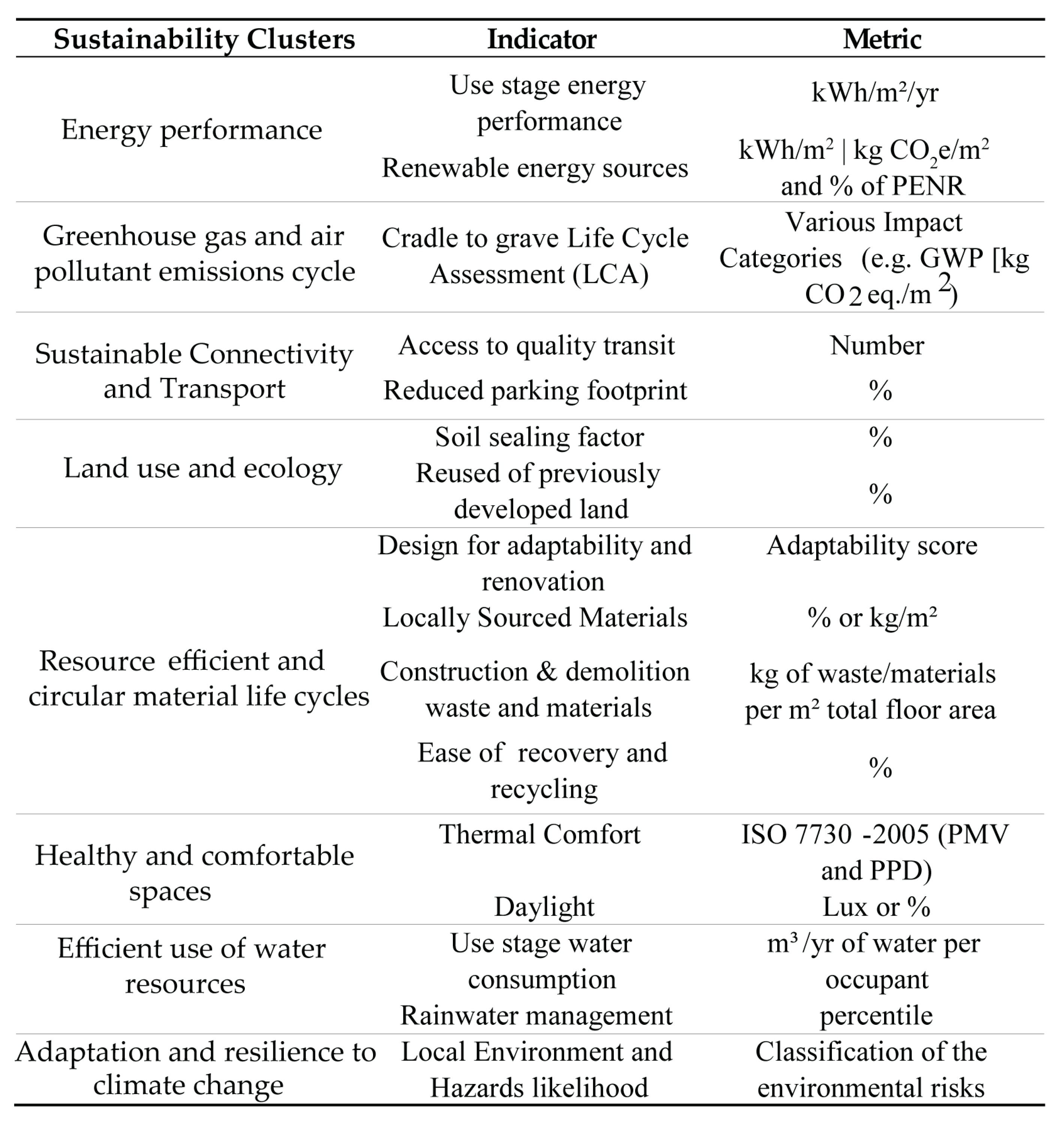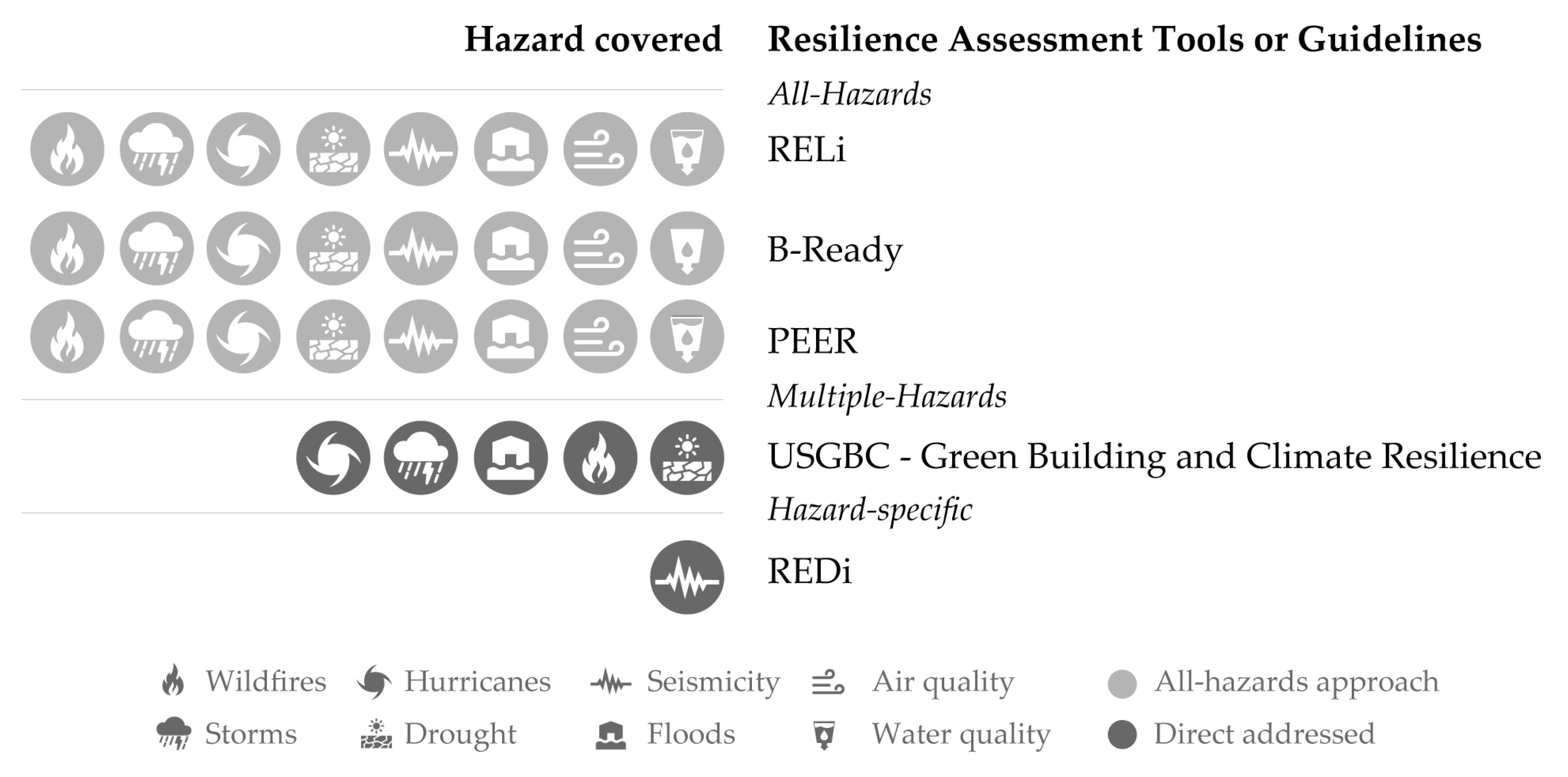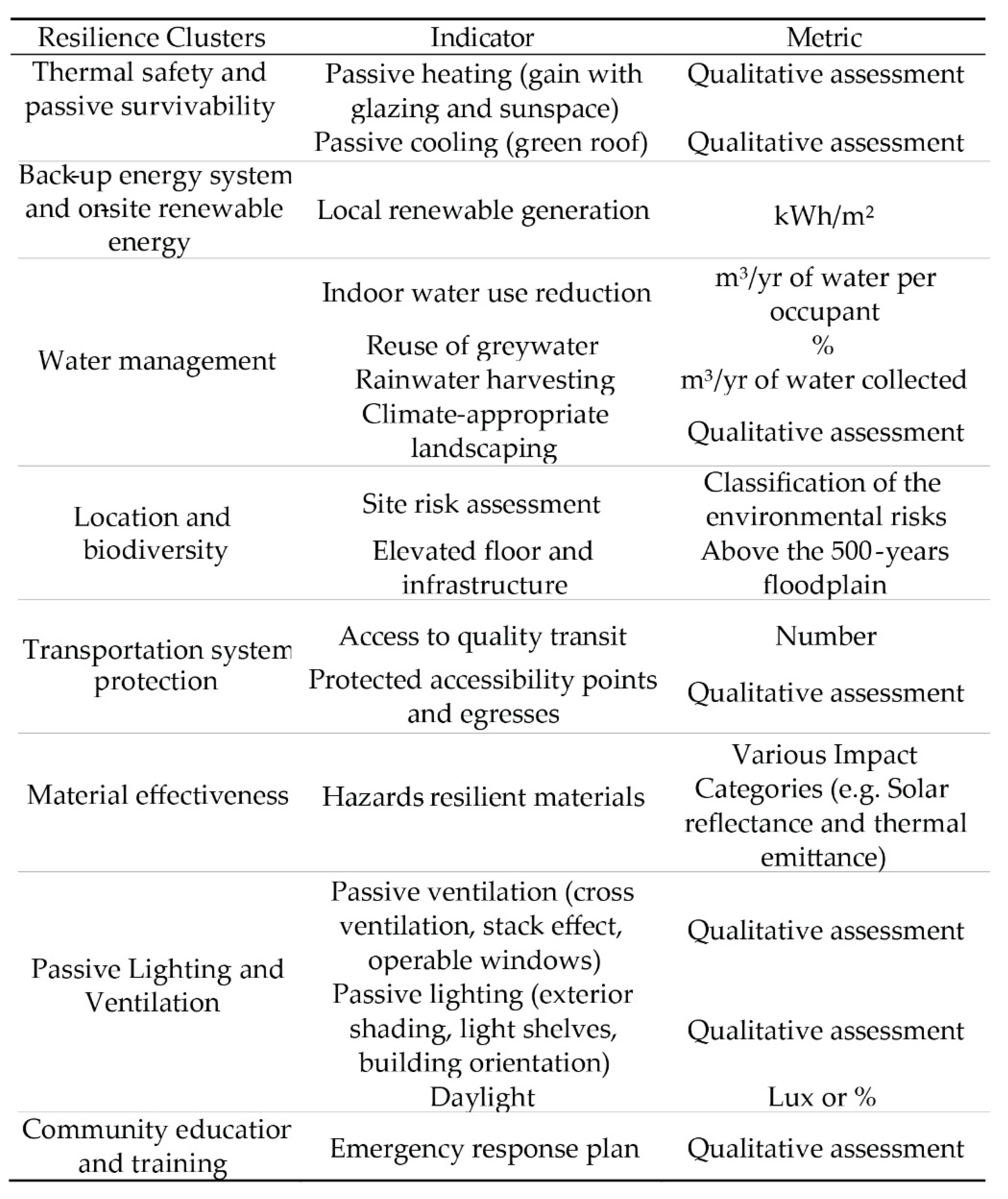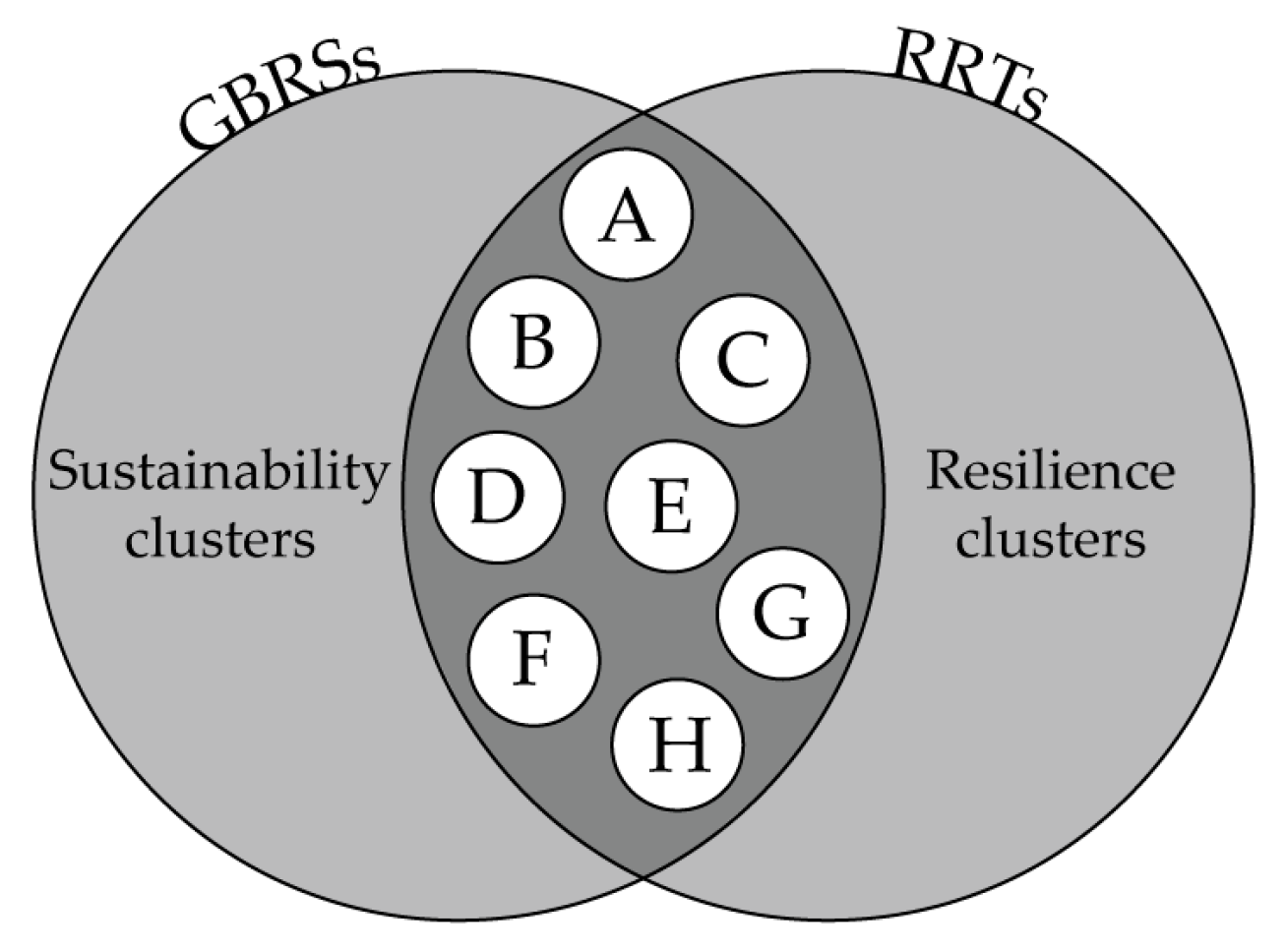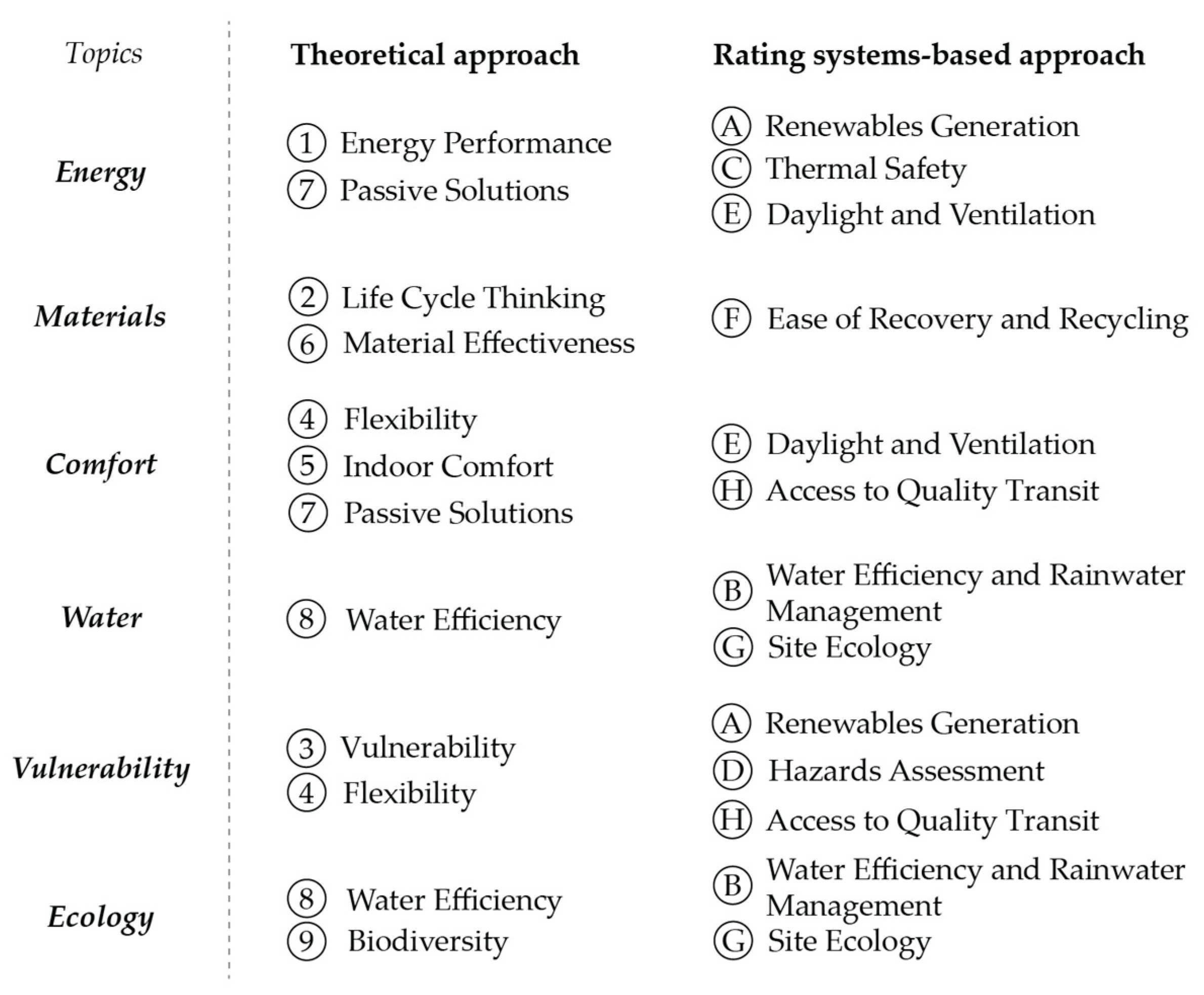1. Introduction
In the last decade, severe natural events, such as floods, wildfires, heat and cold waves, and droughts, resulting in significant loss of life and economic damage [
1], have continued to occur at an increasing rate, demonstrating the intensity of climate change (CC) and its impact on the natural and built environment [
2]. The 2021 report of the Intergovernmental Panel on Climate Change (IPCC) [
3] shows that the emissions of greenhouse gases (GHG) from human activities are responsible for approximately 1.1 °C of warming from 1850 to 1900 and significantly contributed to the alteration of the local climatic conditions in the built environment (i.e., urban heat islands). In their report, IPCC experts have emphasised the irreversible consequences of temperature increase and urged action to reduce CO
2 emissions in the short term [
4].
In addition to being responsible for 36% of emissions and 40% of energy consumption in the EU, the built environment represents a promising sector for massive savings, but at the same time, one of the most vulnerable to the impacts of CC [
5].
Thus, defining effective, resilience-improving strategies to reduce vulnerability to disaster events, rather than working in just a reactive mode [
6], represents a crucial issue for the near future. The international super-governmental bodies aim to address the possible causes by setting mitigation and adaptation measures for the medium and long term. Within these strategies, some specific indications for the building sector are embedded within the 2015 United Nations (UN) Sustainable Development Goals (SDGs) [
7], where some principles of building design are linked to design for sustainability and resilience. The interrelationship of the two domains of sustainability and resilience needs to be studied to expedite the progress of building resilience at the local level towards achieving several international targets [
8,
9,
10].
1.1. Sustainability and Resilience at Different Scales
According to [
11,
12,
13], building sustainability refers to reducing the negative effects on the environment, while resilience refers to the way in which a building can adapt to changes imposed by CC.
Since the 1990s, different standards and certifications have been developed and used to ensure improved sustainability in buildings, such as Leadership in Energy and Environmental Design (LEED) [
14] in the United States, Building Research Establishment Environmental Assessment Method (BREEAM) [
15] in the United Kingdom, or Deutsche Gesellschaft für Nachhaltiges Bauen (DGNB) [
16] in Germany. Currently, resilience is a big priority in the construction sector and often overlaps with the concept of sustainability, which has existed for a much longer time. As a consequence, a question arises as to whether resilience is a subset or something independent of sustainability [
13]. Still, resilience to natural and manmade hazards is rarely included in green building rating systems (GBRSs) [
17].
Although the precise meaning of building resilience is indeterminate, many organisations have tried to define this issue. For instance, the Rockefeller Center states that city resilience is the ”overall capacity of a city (individuals, communities, institutions, businesses and systems) to survive, adapt and thrive no matter what kinds of chronic stresses or acute shocks they experience” [
18]. Within this paper, resilience is assumed as the ability of a system, entity, community, or person to adapt to changing conditions, resist shocks while still preserving the essential functions, and recover all system features to a pre-disaster level. In the urban environment, improving building resilience has been associated with disaster risk reduction; moreover, when combined with urban resilience strategies, it can serve as a driving force for urban planning in the future [
19].
The analysis of resilience is enhanced when a building is used as the unit of analysis, rather than a city or neighbourhood, as this allows a better understanding of how the building operators and managers (as key players within the building) deal with disruptions in the building system. This fact is especially significant because the most impacted user group from any resilience efforts (at any scale) are the end-users, who sometimes have limited control of the building system. Thus, since, in many cases, residential buildings are multifamily buildings, the owners and managers, having more power than building occupants, can influence and take purposeful actions in the building system to make it more resilient to ensure acceptable living conditions, including in case of extreme events [
20]. Thus, the main idea behind this article is that two design processes, sustainability and resilience, are being discussed more and more by building and city experts and professionals, but there is little understanding of whether these are similar and could eventually be synergistic or whether there are contradictions [
21]. To answer this question, a systematic literature review and analysis of building rating systems is needed. Identifying common clusters between the theoretical assumptions derived from the literature and the potential application within GBRSs/real construction processes can provide answers to the question of whether the two approaches overlap and how this is extended.
1.2. Scope and Objectives
This study reviews the commonalities of sustainability and resilience at the building level following two methods: a theoretical-based literature review and a rating-systems-based approach focused on investigating GBRSs and resilience rating systems (RRSs) and guidelines. Hence, the main objectives are (i) to identify the amount of research focused on both sustainability and resilience, and (ii) to define clusters and metrics of sustainability and resilience and to identify common clusters and synergies.
2. Materials and Methods
Since the main scope of this study is to point out the common ground between the domains of sustainability and resilience (
Figure 1), the very first step of the process was to investigate their current notions and definitions within the scientific literature.
A systemic review from electronic databases was therefore conducted.
Figure 2 provides a conceptual workflow of the investigation process, which compares the outcomes of the literature review with the structure and consistency of the GBRSs and RRSs.
Accordingly, a critical reflection addressed to the thematic cluster definition follows as a discussion regarding the two approaches and the future research trends in this sector.
2.1. Theoretical Research
The search was conducted in the Web of Science, Scopus, and Science Direct databases, which were chosen for their reputation in indexing high-quality and peer-reviewed papers and since they are managed by third parties. To control the quality and uniformity of data, the document types were limited to “reviews”, “articles”, “conference papers”, and “books/book chapters”, and the selected language was “English”. The timespan set for this investigation was from 2002 to 2022, which is assumed as the “maturation period” of both the domains in which the larger scientific production was registered. The title, keywords, and abstracts of the papers were identified according to the following strings in each database:
Sustainable building OR sustainable design OR sustainable construction OR sustainable built environment;
Resilient building OR resilient design OR resilient construction OR resilient built environment.
Due to the fact that this study aims to identify the common ground between sustainability and resilience, additional narrowed research was conducted in the electronic databases to select records pertaining to sustainability in buildings which consider resilience aspects and vice versa. Moreover, since resilience is a more recent and less established concept, only the last ten years (2012–2022) were finally considered.
Figure 3 shows the PRISMA diagram [
22] that illustrates the second-phase reviewing process. Once the data search was completed (1659 records identified), 7 additional records were identified through hand-searching, 744 duplicate records were removed, and a total of 922 records were selected for the screening process. For identifying patterns and trends, the VOSviewer tool (open-source software) [
23,
24] was used because it provides some analysis of recurrence of keywords that are useful to direct the search and immediately gain insights on emerging aspects. Titles and abstracts were then screened, and irrelevant results were excluded because the resilience aspect was only marginally considered. Hence, 86 full-text records were selected for the eligibility check. After reading the full-text records, a total of 47 records were included in this study.
2.2. Rating-Systems-Based Approach
GBRSs and RRSs can also be used for identifying the clusters for sustainability and resilience at the building level. Among the several available GBRSs [
25],
Table 1 shows key facts about the diffusion and application of the three most recurring ones at the European level, according to [
26].
Thus, the New Construction version of BREEAM [
15], DGNB [
16], and LEED [
14] were carefully selected for this paper, assuming that these protocols have an essential role in setting directions for further sustainable strategies. Moreover, the new European sustainable framework Level(s) [
29]—which was specifically developed to provide a common language among the rating systems—was also considered. Additionally, the RIBA design process [
30], a well-known industry-standard planning method, particularly the RIBA Sustainable Outcomes [
31], was included in the sustainable design domain.
After a screening among the currently available RRSs,
Table 2 shows the five tools and guidelines that were chosen.
RELi was selected as being directly designed for LEED-certified buildings. REDi, also mentioned in RELi, is specifically designed to improve buildings’ seismic response capacity. B-Ready was included as being one of the few protocols developed outside the US context. PEER is focused on energy efficiency and the environment. USGBC is the leading solution promoted by the United States Green Building Council.
Each selected GBRS and RRS has been carefully analysed to summarise (a) the key objectives; (b) the data to be collected; and (c) the metrics used to generate the rating scheme. Then, the tools were compared to assess their commonalities (including meaningful metrics) (
Figure 4).
Following a thorough analysis of these rating systems (RSs) (criterion-by-criterion approach), several criteria were grouped into clusters. Based on this analysis, common clusters were recognised, taking into account the indicators and main effects of the strategies.
3. Results
3.1. Theoretical Research: Systematic Literature Review
The literature research was conducted between July and November 2022. The first search round produced 8437 results for the sustainability domain and 1130 results for the resilience domain, whose combined distribution over the 20-year range is reported in
Figure 5. Not surprisingly, while sustainability has been extensively explored during the past 20 years, resilience is a relatively more recent field of study.
In the second research round, only the last 10 years, from 2012 to 2022, were considered (
Figure 6) to refine the process within a more balanced background knowledge, given that the detection of the common ground between the two domains was the main scope of this study.
After this analysis, the papers were entered into VOSviewer software, selecting the analysis of words co-occurrence both in titles and abstracts and keywords (
Figure 7). Binary counting was then selected, and ten was the minimum number of occurrences of a keyword to be shown on the map. The normalisation was performed with the association strength method. Four clusters were identified. Four clusters can be identified on the map: blue, light blue, green, and yellow. In VOSviewer occurrence analysis, the distance between two words corresponds to a greater distance in terms of the research topic. The blue cluster is dominated by sustainability/resilience/implementation-related words. The light blue cluster is related to management and monitoring. The green cluster contains terms related to the performance of the building. The yellow cluster, which is the last in terms of the number of words, contains topics pertaining to vulnerability and risk analysis. This is a preliminary analysis that will be refined in the following paragraphs.
Figure 8 depicts the distribution patterns of the selected records after they were filtered, duplicates were removed, and eligibility was determined.
Figure 9 illustrates the annual distribution of the records from 2012 to 2022. In comparison with
Figure 6, it is evident that there has been a reduction in quantity since the duplicates were removed, and only the most eligible documents were considered. It is plain that the topic has attracted an increasing amount of attention over the last seven years.
In the analysis of the records regarding the combination of sustainability and resilience, nine recurring clusters were identified (
Figure 10), which illustrates that simultaneous consideration of both domains has already been recognised in some specific instances.
The identified clusters are listed in
Table 3. In many records, one option to achieve a sustainable and resilient building entails considering low-energy solutions, as reported by [
37] and [
38], thus falling in the “Energy Performance” category. Other examples are the studies of Menna et al. [
39] and Marini et al. [
40] that consider Life Cycle Assessment for structural retrofitting against seismic hazards while including environmental impacts, thus falling in the “Life Cycle Thinking” category.
These clusters are a way of clustering the topics that were investigated in the selected records and reported in
Figure 11, where primary references and secondary references are highlighted.
Appendix A presents the other clusters (
Figure A1,
Figure A2,
Figure A3 and
Figure A4).
Primary references are those whose focus is primarily on the topic in question, while secondary references are those which refer to the topic but in a relatively generalised manner. More subsets of topics are pertinent to different clusters, such as adaptable technologies (e.g., the study of [
62] or [
69]), which falls into the Indoor Comfort category and the Flexibility one.
3.2. Rating-Systems-Based Approach
3.2.1. Analysis of GBRSs
Traditionally, resilience and sustainability have been approached as separate issues [
45]. For the aim of this paper, five GBRSs were reviewed (i.e., LEED, BREEAM, DGNB, Level(s), and RIBA). According to the reported methodology, eight common clusters were detected. The methodological system based on clusters allows the definition of a sort of circle in which more subsets can be considered. However, the circle has blurred edges because the cluster may eventually be specified more in detail, adding new features but without necessarily introducing new clusters.
Table 4 shows these clusters and their definitions. Most of these tools chosen for the investigation do not equally address all three levels of sustainability (i.e., environmental, social, and economic). Most emphasis is placed on environmental impacts, ignoring the importance of social and economic impacts [
83]. Indeed, the economic level was present only in Level(s), DGNB, and RIBA, which is why economic sustainability is not included in the table. Therefore, it can be argued that these systems provide a measure of sustainability even though they focus primarily on environmental impacts.
As shown in
Figure 12, each cluster is included in each protocol, but in a different proportion based on the number of criteria that fall within each—in the figure, it is not the weight of each criterion/credit but the credit itself, rather than its “importance”, that is considered in the overall framework. For example, within the cluster Healthy and Comfortable spaces, there are criteria such as Light Pollution Reduction under the LEED system (Sustainable Site category) or Design for All under the DGNB system (SOC2.1). Each tool contains a percentage labelled “Others”, which represents criteria/credits that are not present in every tool (and therefore it was not possible to cluster them), e.g., Life Cycle Costing.
Based on the criteria weights of each tool,
Figure 13 illustrates the distribution of clusters. The analysis was limited to tools that operate on a point basis.
Sustainability performance needs to be measured, quantified, and/or assessed in order to determine which construction system, technique, or material performs from a sustainability point of view. Thus, a metric is always specified and stated. Indeed, the clusters present indicators and specific metrics that are shown in
Figure 14 and were taken from the analysis and comparison of the sustainable tools and methods. Examples include LCA for new potential material, energy consumption and CO
2 emissions of a building, etc.
3.2.2. Analysis of RRSs
To define how the building sector conceptualises resilience and to determine the metrics, resilience initiatives, programs, and frameworks that directly address the resilience of buildings were investigated. These involved general guidance documents, standards, and building design and construction strategies that stakeholders could use within the building sector to identify strategies to enhance building resilience.
These documents address different hazards, as
Figure 15 shows. Many extreme events, such as strong winds, earthquakes, and floods, have specific design criteria in current codes and standards for the built environment. However, three of the five resilience documents (PEER, RELi, and B-READY) address climate change hazards as part of a vulnerability assessment or all-hazards approach. They usually describe and set general pathways to follow that can be applied to any disaster event. For example, strategies such as maintaining back-up power to critical systems, building community ties, providing refuge areas for at least four days, developing emergency management plans, planning for long-term monitoring and maintenance, and managing system redundancy are not hazard-specific. They can be applied to improve the overall resilience of a building.
Conversely, the other documents are more hazard-specific (developed to face one or two types of extreme events), such as REDi, a framework mainly focused on seismic activity resilience.
However, the most common hazards covered by these documents are flooding, heat waves, and severe storms, while other hazards, such as air and water quality, drought, and wildfires, are not as extensively covered
Following the analysis performed according to the proposed methodology, the results of this investigation are presented in
Table 5 as resilience clusters.
Even in this case, there are more or fewer criteria/credits for each tool that fall within those clusters (
Figure 16). For example, within the cluster Thermal Safety and Passive Survivability, there are criteria such as Passive Thermal Safety, Thermal Comfort + Lighting Design Strategies under the RELi system (hazard mitigation + adaptation, HA3) or Passive Solar Design under the USGBC guidelines (heating, cooling, lighting category). As for the sustainability clusters, each protocol contains a part labelled “Other”, which represents criteria/credits that are not present in every tool (and therefore it was not possible to cluster them).
The resilience metrics of these clusters, shown in
Figure 17, come in various types. They can be qualitative or quantitative, as for the local renewable generation or indoor water use reduction; they can be based on interviews, expert opinion, engineering analysis, or pre-existing datasets, such as the site risk assessment. They can also be presented as an overall score or a set of separately reported scores across physical, economic, social, and environmental dimensions as for the hazard-resilient materials. These metrics help assess each objective’s current level of resilience and the potential benefits of actions to improve its resilience.
3.2.3. Common Clusters
According to the previous analysis, it was possible to highlight the common clusters, indicators, and metrics for each of the two domains, as shown in
Figure 18 and
Figure 19.
Figure 19 shows the common clusters of sustainability and resilience in buildings, along with their descriptions and the expected effects of using strategies that belong to those clusters. The most recurrent strategy is designing passive solutions that can be applied for different purposes (heating, cooling, lighting, and ventilation), or, for example, renewable energy strategies will reduce a building’s dependency on the electrical grid and reduce carbon emissions and potentially make the building more resilient to power outages.
4. Discussion
It has been observed from the literature review that sustainability and resilience at the building level have been receiving increased attention in recent years as researchers, architects, designers, and other pertinent stakeholders have been working to mitigate the effects of climate change. In the records selected from the literature review, the main clusters into which the strategies and solutions were grouped were Energy Efficiency and Passive Solutions. The same results emerged considering the RSs. Indeed, in these ratings, the energy consumption indicator is a core concept because the total energy demand is used to evaluate the building’s energy efficiency. The components are the heating, cooling, ventilation, and lighting that work with HVAC systems, boilers, and lighting appliances, and consequently they need electricity to be operative. Still, passive techniques that replace the previously mentioned systems are recommended.
Figure 20 shows how these approaches resulted in the clustered topics. For example, regarding the Materials topic, both approaches suggest a willingness to encourage reuse of, recycling of, and prolonging the life cycle of a material in order to reduce the amount of waste that must be sent to a landfill.
Figure 20 makes evident the commonalities between the two domains and highlights how much room there is to introduce resilience-enhancing criteria into existing GBRSs, mostly employed during the building design since resilience should be viewed as a prerequisite for a green rating and vice versa.
The common clusters are generated by the current knowledge of the two domains with respect to the activity of the scientific community and RSs, but this can rapidly evolve over time. Based on the exponential increase in publications in the field of sustainability, it is reasonable to conclude that progress and a greater interest in the investigation of resilience are likely to occur in the near future, providing an opportunity for updating this study. Nevertheless, it is possible to consider the proposed methodology solid enough to let the clusters be eventually specified without necessarily introducing new ones. If it is necessary to add a new category, it would be sufficient to add scores and evaluate their weight. Clusters do not all weigh the same, as, for instance, GBRSs highlight, but this study has not focused on determining the weight of each cluster which could represent a further step in the process. Further, it is important to note that aspects of social and economic sustainability were not included, despite the fact that it might have been interesting to highlight whether these aspects are also relevant to resilience. This choice was taken because most of the GBRSs selected do not address all levels of sustainability (i.e., environmental, social, and economic) equally; thus, a boundary encompassing only the environmental aspects was set. The authors are aware that there are differences in terms of priorities and effects, but this will be the subject of future studies.
5. Conclusions
Recent years have seen many European countries introduce the requirement to undergo environmental assessment for building projects; in the UK, for example, each new-build construction project must achieve a BREEAM Outstanding rating as part of the government’s Construction Strategy [
84]; in Germany, federal buildings must meet BNB (Assessment System for Sustainable Building) certification requirements as required by the federal government’s sustainable development strategy [
85]; and in Italy, specifically in the Puglia region, non-residential buildings are required to comply with Protocollo ITACA when they are financed in part by public funds [
86]. This trend is likely to increase over the next 5–10 years to improve the built environment’s quality.
Even if many actions have been made to include sustainability at the building level, the concept of resilience is still quite recent and not fully considered yet, but several concerns have arisen regarding identifying the common ground between sustainability and resilience at the level of the building.
By combining two different approaches (i.e., a theoretical-based one (literature review) and rating-systems-based one), this study identified common clusters and indicators that encompass both domains. Based on the findings, both approaches share similar clusters, implying that sustainability and resilience can be considered simultaneously while designing a project. In the process of implementing sustainable and resilient measures, it is crucial to balance the performance of each domain without skewing too much in one direction or the other. These common clusters may assist in finding a balance.
Further, it is essential to identify some irreplaceable key indicators in the design process. This would allow a building to reflect the concept of resilience while incorporating aspects of sustainability. Therefore, there would be greater opportunities to address the building sector, especially new construction, to meet the SDGs’ future challenges.
A number of stakeholders in the building sector, including architects, managers and operators, and community organisations, may benefit from this study, which indicates that synergies between the two domains are possible and a consistent overlap exists, demonstrating the importance of incorporating sustainability and resilience strategies into building planning processes when performance-based tools are typically employed. The purpose of this research was to lay the groundwork for a quantitative study to be conducted in the future.
Author Contributions
Conceptualisation, L.F., A.L. and J.G.; methodology, L.F., A.L. and J.G.; formal analysis, L.F.; investigation, L.F.; resources, L.F.; data curation, L.F.; writing—original draft preparation, L.F.; writing—review and editing, L.F., A.L. and J.G.; visualisation, L.F.; supervision, A.L. and J.G. All authors have read and agreed to the published version of the manuscript.
Funding
This research has been supported by the Czech Technical University in Prague [grant number SGS22/084/OHK1/2 T/11] and the Ministry of Education, Youth and Sports within and within project INTER-EXCELLENCE No. LTT19022.
Institutional Review Board Statement
Not applicable.
Informed Consent Statement
Not applicable.
Data Availability Statement
Not applicable.
Conflicts of Interest
The authors declare no conflict of interest.
Appendix A
Figure A1.
Clusters (specifically Vulnerability [
39,
46,
50,
52,
53,
54,
55,
56,
57,
58,
59,
69,
79,
80] and Flexibility [
43,
44,
49,
56,
59,
60,
61,
62,
63,
64,
65,
66,
68,
74,
81]) from the selected records resulted from the literature review and selected records (keywords found in the records belonging to each thematic category in yellow stickers, research articles in light blue ones, review articles in blue ones, and conference papers in black ones).
Figure A1.
Clusters (specifically Vulnerability [
39,
46,
50,
52,
53,
54,
55,
56,
57,
58,
59,
69,
79,
80] and Flexibility [
43,
44,
49,
56,
59,
60,
61,
62,
63,
64,
65,
66,
68,
74,
81]) from the selected records resulted from the literature review and selected records (keywords found in the records belonging to each thematic category in yellow stickers, research articles in light blue ones, review articles in blue ones, and conference papers in black ones).
Figure A2.
Clusters (specifically Indoor Comfort [
38,
41,
44,
67,
68,
69,
70,
71,
72,
74,
77,
78,
81] and Material Effectiveness [
40,
47,
63,
66,
73,
74,
75,
76]) from the selected records resulted from the literature review and selected records (keywords found in the records belonging to each thematic category in yellow stickers, research articles in light blue ones, review articles in blue ones, and conference papers in black ones).
Figure A2.
Clusters (specifically Indoor Comfort [
38,
41,
44,
67,
68,
69,
70,
71,
72,
74,
77,
78,
81] and Material Effectiveness [
40,
47,
63,
66,
73,
74,
75,
76]) from the selected records resulted from the literature review and selected records (keywords found in the records belonging to each thematic category in yellow stickers, research articles in light blue ones, review articles in blue ones, and conference papers in black ones).
Figure A3.
Clusters (specifically Passive Solutions [
61,
62,
64,
68,
69,
71,
72,
75,
77,
78,
79,
82] and Water Efficiency [
53,
68,
77,
80,
81,
82]) from the selected records resulted from the literature review and selected records (keywords found in the records belonging to each thematic category in yellow stickers, research articles in light blue ones, review articles in blue ones, and conference papers in black ones).
Figure A3.
Clusters (specifically Passive Solutions [
61,
62,
64,
68,
69,
71,
72,
75,
77,
78,
79,
82] and Water Efficiency [
53,
68,
77,
80,
81,
82]) from the selected records resulted from the literature review and selected records (keywords found in the records belonging to each thematic category in yellow stickers, research articles in light blue ones, review articles in blue ones, and conference papers in black ones).
Figure A4.
Biodiversity category from the selected records [
41,
48,
75,
77,
80,
82] resulted from the literature review and selected records (keywords found in the records belonging to each thematic category in yellow stickers, research articles in light blue ones, review articles in blue ones, and conference papers in black ones).
Figure A4.
Biodiversity category from the selected records [
41,
48,
75,
77,
80,
82] resulted from the literature review and selected records (keywords found in the records belonging to each thematic category in yellow stickers, research articles in light blue ones, review articles in blue ones, and conference papers in black ones).
References
- Felicioni, L.; Lupíšek, A.; Hájek, P. Major European Stressors and Potential of Available Tools for Assessment of Urban and Buildings Resilience. Sustainability 2020, 12, 7554. [Google Scholar] [CrossRef]
- Wallemacq, P. Economic Losses, Poverty and Disasters 1998–2017; United Nations Office for Disaster Risk Reduction: Geneva, Switzerland, 2018. [Google Scholar]
- Intergovernmental Panel on Climate Change IPCC. Available online: https://www.ipcc.ch/ (accessed on 1 September 2021).
- Intergovernmental Panel on Climate Change. Climate Change 2021: The Physical Science Basis; IPCC: Geneva, Switzerland, 2021. [Google Scholar]
- European Commission. In focus: Energy Efficiency in Buildings. Available online: https://ec.europa.eu/info/news/focus-energy-efficiency-buildings-2020-feb-17_en (accessed on 1 September 2021).
- Lomba-Fernández, C.; Hernantes, J.; Labaka, L. Guide for climate-resilient cities: An urban critical infrastructures approach. Sustainability 2019, 11, 4727. [Google Scholar] [CrossRef]
- Dobie, S.; Schneider, J. Development of a process improvement matrix to measure community level sustainability and resilience: A collaborative case study of Rochester, NY, USA. In Proceedings of the 2017 IEEE International Symposium on Technologies for Homeland Security (HST), Waltham, MA, USA, 25–26 April 2017; pp. 1–5. [Google Scholar] [CrossRef]
- United Nations. The Sustainable Development Goals; United Nations: New York, NY, USA, 2015. [Google Scholar]
- UNISDR. National Disaster Risk Assessment; UNISDR: Geneva, Switzerland, 2017. [Google Scholar]
- United Nations Human Settlements Programme. The New Urban Agenda; United Nations Human Settlements Programme: Nairobi, Kenya, 2020. [Google Scholar]
- Lizarralde, G.; Chmutina, K.; Bosher, L.; Dainty, A. Sustainability and resilience in the built environment: The challenges of establishing a turquoise agenda in the UK. Sustain. Cities Soc. 2015, 15, 96–104. [Google Scholar] [CrossRef]
- Phillips, R.; Troup, L.; Fannon, D.; Eckelman, M.J. Do resilient and sustainable design strategies conflict in commercial buildings? A critical analysis of existing resilient building frameworks and their sustainability implications. Energy Build. 2017, 146, 295–311. [Google Scholar] [CrossRef]
- Roostaie, S.; Nawari, N.; Kibert, C.J. Sustainability and resilience: A review of definitions, relationships, and their integration into a combined building assessment framework. Build. Environ. 2019, 154, 132–144. [Google Scholar] [CrossRef]
- USGBC. LEED v4.1 Building Design and Construction; USGBC: Washington, DC, USA, 2021. [Google Scholar]
- BREEAM. BREEAM International New Construction 2016—Technical Manual; BREEAM: Watford, UK, 2016. [Google Scholar]
- DGNB. DGNB System New Construction, Buildings Criteria Set—Version 2020; DGNB: Stuttgart, Germany, 2020. [Google Scholar]
- Roostaie, S.; Nawari, N. The DEMATEL approach for integrating resilience indicators into building sustainability assessment frameworks. Build. Environ. 2022, 207, 108113. [Google Scholar] [CrossRef]
- ARUP. City Resilience Index: Understanding and Measuring City Resilience; ARUP: London, UK, 2016. [Google Scholar]
- Kim, D.; Lim, U. Urban resilience in climate change adaptation: A conceptual framework. Sustainability 2016, 8, 1–17. [Google Scholar] [CrossRef]
- Hewitt, E.; Oberg, A.; Coronado, C.; Andrews, C. Assessing “green” and “resilient” building features using a purposeful systems approach. Sustain. Cities Soc. 2019, 48, 101546. [Google Scholar] [CrossRef]
- Gholami Rostam, M.; Abbasi, A. A framework for identifying the appropriate quantitative indicators to objectively optimize the building energy consumption considering sustainability and resilience aspects. J. Build. Eng. 2021, 44, 102974. [Google Scholar] [CrossRef]
- PRISMA. PRISMA Workflow. Available online: http:/%0A/www.prisma-statement.org/PRISMAStatement/FlowDiagram (accessed on 11 October 2022).
- van Eck, N.J.; Waltman, L. Visualizing Bibliometric Networks. In Measuring Scholarly Impact; Ding, Y., Rousseau, R., Wolfram, D., Eds.; Springer: Cham, Switzerland, 2014; pp. 285–320. ISBN 978-3-319-10376-1. [Google Scholar]
- VOSviewer—Visualizing Scientific Landscapes. Available online: https://www.vosviewer.com/ (accessed on 20 December 2022).
- Marchi, L.; Antonini, E.; Politi, S. Green Building Rating Systems (GBRSs). Encyclopedia 2021, 1, 998–1009. [Google Scholar] [CrossRef]
- Cordero, A.S.; Melgar, S.G.; Márquez, J.M.A. Green building rating systems and the new framework level(s): A critical review of sustainability certification within Europe. Energies 2019, 13, 66. [Google Scholar] [CrossRef]
- LEED. Available online: https://www.usgbc.org/leed (accessed on 1 November 2021).
- BREEAM. Available online: https://www.breeam.com/ (accessed on 2 November 2021).
- DGNB System. Available online: https://www.dgnb-system.de (accessed on 2 November 2021).
- RIBA. RIBA Plan of Work. Available online: https://www.architecture.com/knowledge-and-resources/resources-landing-page/riba-plan-of-work (accessed on 1 November 2021).
- RIBA. Sustainable Outcomes Guide; RIBA: London, UK, 2019. [Google Scholar]
- USGBC. RELi 2.0 Rating Guidelines for Resilient Design + Construction; USGBC: Washington, DC, USA, 2018. [Google Scholar]
- Almufti, I.; Willford, M.; Delucchi, M.; Davis, C.; Hanson, B.; Langdon, D.; Friedman, D.; Johnson, L.; Nielsen, G.; Riordan, N.O.; et al. REDi TM Rating System; ARUP: London, UK, 2013. [Google Scholar]
- Kot, D. B-READY. Available online: https://www.dnv.com/services/b-ready-106852 (accessed on 2 November 2022).
- GBCI. PEER v2 Reference Guide; GBCI: Washington, DC, USA, 2018. [Google Scholar]
- Larsen, L.; Rajkovich, N.; Leighton, C.; McCoy, K.; Calhoun, K.; Mallen, E.; Bush, K.; Enriquez, J.; Pyke, C.; McMahon, S.; et al. Green Building and Climate Resilience: Understanding Impacts and Preparing for Changing Conditions; U.S. Green Building Council: Washington, DC, USA, 2011. [Google Scholar]
- Georgiadou, M.C.; Hacking, T.; Guthrie, P. A conceptual framework for future-proofing the energy performance of buildings. Energy Policy 2012, 47, 145–155. [Google Scholar] [CrossRef]
- Nunes, G.; Giglio, T. Effects of climate change in the thermal and energy performance of low-income housing in Brazil—Assessing design variable sensitivity over the 21st century. Renew. Sustain. Energy Rev. 2022, 168, 112885. [Google Scholar] [CrossRef]
- Menna, C.; Felicioni, L.; Negro, P.; Lupíšek, A.; Romano, E.; Prota, A.; Hájek, P. Review of methods for the combined assessment of seismic resilience and energy efficiency towards sustainable retrofitting of existing European buildings. Sustain. Cities Soc. 2022, 77, 103556. [Google Scholar] [CrossRef]
- Marini, A.; Passoni, C.; Belleri, A. Life cycle perspective in RC building integrated renovation. In Procedia Structural Integrity, Proceedings of the Xiv International Conference on Building Pathology and Constructions Repair, Florence, Italy, 20–22 June 2018; Elsevier B.V.: Amsterdam, The Netherlands, 2018; Volume 11, pp. 28–35. [Google Scholar]
- Nadal, A.; Llorach-Massana, P.; Cuerva, E.; López-Capel, E.; Montero, J.I.; Josa, A.; Rieradevall, J.; Royapoor, M. Building-integrated rooftop greenhouses: An energy and environmental assessment in the mediterranean context. Appl. Energy 2017, 187, 338–351. [Google Scholar] [CrossRef]
- Mesquita, L.; Ripper Kós, J. Towards more resilient and energy efficient social housing in Brazil. Energy Procedia 2017, 121, 65–70. [Google Scholar] [CrossRef]
- Carr, J.; Brissette, A.; Ragaini, E.; Omati, L. Managing Smart Grids Using Price Responsive Smart Buildings. Energy Procedia 2017, 134, 21–28. [Google Scholar] [CrossRef]
- Lassandro, P.; Di Turi, S. Façade retrofitting: From energy efficiency to climate change mitigation. Energy Procedia 2017, 140, 182–193. [Google Scholar] [CrossRef]
- Cariolet, J.M.; Vuillet, M.; Colombert, M.; Diab, Y. Building resilient and sustainable: A need to decompartementalise the researches. In Proceedings of the E3S Web of Conferences, Lyon, France, 17–21 October 2016; Volume 7. [Google Scholar]
- Angeles, K.; Patsialis, D.; Taflanidis, A.A.; Kijewski-Correa, T.L.; Buccellato, A.; Vardeman, C. Advancing the Design of Resilient and Sustainable Buildings: An Integrated Life-Cycle Analysis. J. Struct. Eng. 2021, 147, 1–19. [Google Scholar] [CrossRef]
- Hay, R.; Ostertag, C.P. Innovative double skin facąde (DSF) with high performance green hybrid fiber-reinforced concrete (HP-G-HyFRC) for resilient and sustainable buildings. In Proceedings of the AEI 2015: Birth and Life of the Integrated Building—Proceedings of the AEI Conference 2015, Milwaukee, WI, USA, 24–27 March 2015; pp. 120–133. [Google Scholar]
- Kohler, N. From the design of green buildings to resilience management of building stocks. Build. Res. Inf. 2018, 46, 578–593. [Google Scholar] [CrossRef]
- Shahtaheri, Y.; de la Garza, J.M.; Flint, M.M. Modular Preference Function Development Strategy for the Design of Multi-Hazard Resilient and Sustainable Buildings. In Proceedings of the Congress on Technical Advancement 2017, Duluth, MN, USA, 10–13 September 2017; pp. 65–76. [Google Scholar]
- Dong, Y.; Fragopol, D.M. Performance-based seismic assessment of conventional and base- isolated steel buildings including environmental impact and resilience. Earthq. Eng. Struct. Dyn. 2016, 45, 739–756. [Google Scholar] [CrossRef]
- Arcese, G.; Traverso, M. Sustainability and Resilience Assessment in the Pandemic Emergency. Symphonya. Emerg. Issues Manag. 2021, 2, 99–117. [Google Scholar] [CrossRef]
- Matthews, E.; Friedland, C.J.; Orooji, F. Optimization of Sustainability and Flood Hazard Resilience for Home Designs. In Procedia Engineering, Proceedings of the ICSDEC 2016—Integrating Data Science, Construction and Sustainability, Tempe, AZ, USA, 18–20 May 2016; Elsevier B.V.: Amsterdam, The Netherlands, 2016; Volume 145, pp. 525–531. [Google Scholar]
- Aleksić, J.; Kosanović, S.; Tomanović, D.; Grbić, M.; Murgul, V. Housing and Climate Change-related Disasters: A Study on Architectural Typology and Practice. In Procedia Engineering, Proceedings of the 15th International Scientific Conference “Underground Urbanisation as a Prerequisite for Sustainable Development”, St. Petersburg, Russia, 12–15 September 2016; Elsevier: Amsterdam, The Netherlands, 2016; Volume 165, pp. 869–875. [Google Scholar]
- Cerè, G.; Rezgui, Y.; Zhao, W. Critical review of existing built environment resilience frameworks: Directions for future research. Int. J. Disaster Risk Reduct. 2017, 25, 173–189. [Google Scholar] [CrossRef]
- Cutter, S.L. Building Disaster Resilience: Steps toward Sustainability. Challenges Sustain. 2014, 1, 72–79. [Google Scholar] [CrossRef]
- Hjerpe, M.; Glaas, E.; Hedenqvist, R.; Storbjörk, S.; Opach, T.; Navarra, C. A systematic approach for assessing climate vulnerabilities and adaptation options in large property portfolios: Influences on property owners’ transformative capacity. In Proceedings of the IOP Conference Series: Earth and Environmental Science, Changchun, China, 21–23 August 2020; Volume 588. [Google Scholar]
- Attia, S.; Hamdy, M.; O’Brien, W.; Carlucci, S. Assessing gaps and needs for integrating building performance optimization tools in net zero energy buildings design. Energy Build. 2013, 60, 110–124. [Google Scholar] [CrossRef]
- Roesmanto, T. Resilient design in the conservation of Johar market heritage building. In Proceedings of the IOP Conference Series: Earth and Environmental Science, Zvenigorod, Russia, 4–7 September 2017. [Google Scholar]
- Taki, A.; Doan, V.H.X. A New Framework for Sustainable Resilient Houses on the Coastal Areas of Khanh Hoa, Vietnam. Sustainability 2022, 14, 7630. [Google Scholar] [CrossRef]
- Mosalam, K.M.; Alibrandi, U.; Lee, H.; Armengou, J. Performance-based engineering and multi-criteria decision analysis for sustainable and resilient building design. Struct. Saf. 2018, 74, 1–13. [Google Scholar] [CrossRef]
- Serghides, D.; Dimitriou, S.; Kyprianou, I.; Papanicolas, C. The Adaptive Comfort Factor in Evaluating the Energy Performance of Office Buildings in the Mediterranean Coastal Cities. In Energy Procedia, Proceedings of the Ninth KES International Conference, Chania, Greece, 5–7 July 2017; Elsevier B.V.: Amsterdam, The Netherlands, 2017; Volume 134, pp. 683–691. [Google Scholar]
- Osman, M.M.; Sevinc, H. Adaptation of climate-responsive building design strategies and resilience to climate change in the hot/arid region of Khartoum, Sudan. Sustain. Cities Soc. 2019, 47, 101429. [Google Scholar] [CrossRef]
- Hajek, P. Contribution of concrete structures to sustainability—Challenge for the future. In Proceedings of the IOP Conference Series: Materials Science and Engineering, Valletta, Malta, 10 April 2018; Volume 442. [Google Scholar]
- Mandaglio, M. Chameleon Building. In Proceedings of the IOP Conference Series: Earth and Environmental Science, Milan, Italy, 4–5 September 2019; Volume 296, p. 012014. [Google Scholar] [CrossRef]
- De Castro, D.; Kim, A. Adaptive or absent: A critical review of building system resilience in the leed rating system. Sustainability 2021, 13, 6697. [Google Scholar] [CrossRef]
- Volf, M.; Nehasil, O.; Malík, Z.; Hrabal, D.; Růžička, J.; Lupíšek, A. Resilient and Environmentally Efficient Residential Buildings—Assessment Method and Interim Outcomes. In Proceedings of the IOP Conference Series: Earth and Environmental Science, Changchun, China, 21–23 August 2020; Volume 588, pp. 2–6. [Google Scholar] [CrossRef]
- Tavakoli, E.; O’Donovan, A.; Kolokotroni, M.; O’Sullivan, P.D. Evaluating the indoor thermal resilience of ventilative cooling in non-residential low energy buildings: A review. Build. Environ. 2022, 222, 109376. [Google Scholar] [CrossRef]
- Attia, S.; Levinson, R.; Ndongo, E.; Holzer, P.; Berk Kazanci, O.; Homaei, S.; Zhang, C.; Olesen, B.W.; Qi, D.; Hamdy, M.; et al. Resilient cooling of buildings to protect against heat waves and power outages: Key concepts and definition. Energy Build. 2021, 239, 110869. [Google Scholar] [CrossRef]
- Shum, C.; Zhong, L. Wildfire-resilient mechanical ventilation systems for single-detached homes in cities of Western Canada. Sustain. Cities Soc. 2022, 79, 103668. [Google Scholar] [CrossRef]
- Nicol, L.A.; Knoepfel, P. Resilient housing: A new resource-oriented approach. Build. Res. Inf. 2014, 42, 229–239. [Google Scholar] [CrossRef]
- Fithian, L.A.; Wang, N.; Siddique, Z. Investing in Sustainable Buildings to Enhance Community Resilience. In Proceedings of the AEI 2017, Oklahoma City, OK, USA, 11–13 April 2017; pp. 1034–1043. [Google Scholar]
- Liu, P.; Zhang, Q.; Zhong, K.; Wei, Y.; Wang, Q. Climate Adaptation and Indoor Comfort Improvement Strategies for Buildings in High-Cold Regions: Empirical Study from Ganzi Region, China. Sustainability 2022, 14, 576. [Google Scholar] [CrossRef]
- Watson, S.S.; Ferraris, C.F.; Averill, J.D. Role of materials selection in the resilience of the built environment. Sustain. Resilient Infrastruct. 2018, 3, 165–174. [Google Scholar] [CrossRef]
- Fleischman, R.B.; Kim Seeber, P.E. New construction for resilient cities: The argument for sustainable low damage precast/prestressed concrete building structures in the 21st century. Sci. Iran. 2016, 23, 1578–1593. [Google Scholar] [CrossRef]
- Gambino, V.; Micangeli, A.; Naso, V.; Michelangeli, E.; di Mario, L. A sustainable and resilient housing model for indigenous populations of the Mosquitia region (Honduras). Sustainability 2014, 6, 4931–4948. [Google Scholar] [CrossRef]
- Hajek, P. Advanced high-performance concrete structures—Challenge for sustainable and resilient future. In Proceedings of the MATEC Web of Conferences: ICRMCE 2018, Solo Baru, Indonesia, 11–12 July 2018; Volume 195. [Google Scholar]
- Díaz-López, C.; Serrano-Jiménez, A.; Verichev, K.; Barrios-Padura, Á. Passive cooling strategies to optimise sustainability and environmental ergonomics in Mediterranean schools based on a critical review. Build. Environ. 2022, 221, 109297. [Google Scholar] [CrossRef]
- Silva, R.; Eggimann, S.; Fierz, L.; Fiorentini, M.; Orehounig, K.; Baldini, L. Opportunities for passive cooling to mitigate the impact of climate change in Switzerland. Build. Environ. 2022, 208, 108574. [Google Scholar] [CrossRef]
- Mallawarachchi, H.; De Silva, L.; Rameezedeen, R. Green buildings, resilience ability and the challenge of disaster risk. In Proceedings of the International Conference on Building Resilience, Heritance Ahungalla, Sri Lanka, 17–19 September 2013. [Google Scholar]
- Champagne, C.L.; Aktas, C.B. Assessing the Resilience of LEED Certified Green Buildings. Procedia Eng. 2016, 145, 380–387. [Google Scholar] [CrossRef]
- Javanroodi, K.; Nik, V.M.; Adl-Zarrabi, B. A multi-objective optimization framework for designing climate-resilient building forms in urban areas. In Proceedings of the IOP Conference Series: Earth and Environmental Science, Changchun, China, 21–23 August 2020; Volume 588. [Google Scholar]
- Trombadore, A.; Paludi, B.; Dostuni, M. The energy of the green: Green facades and vertical farm as dynamic envelope for resilient building. J. Phys. Conf. Ser. 2019, 1343, 012172. [Google Scholar] [CrossRef]
- Marjaba, G.E.; Chidiac, S.E. Sustainability and resiliency metrics for buildings—Critical review. Build. Environ. 2016, 101, 116–125. [Google Scholar] [CrossRef]
- Cole, J.; Dell, K. Property Directorate Sustainable Construction: BREEAM Policy; Ministry of Justice: London, UK, 2021. [Google Scholar]
- Federal Ministry of the Interior and Community Sustainable Construction. Available online: https://www.bmi.bund.de/EN/topics/building-housing/building/federal-government-buildings/sustainable-construction/sustainable-construction-node.html (accessed on 20 December 2022).
- Giunta Regionale. Sistema Di Valutazione Del Livello Di Sostenibilità Ambientale Degli Edifici in Attuazione Della Legge Regionale 10 Giugno 2008, N. 13 “Norme per L’abitare Sostenibile” (Art. 10). Approvazione Del “Protocollo ITACA PUGLIA 2017—EDIFICI NON RESIDENZIALI”; Giunta Regionale: Ancona, Italy, 2017; pp. 41820–41995. [Google Scholar]
Figure 1.
Venn diagram to identify the area of investigation.
Figure 1.
Venn diagram to identify the area of investigation.
Figure 2.
Overall research workflow.
Figure 2.
Overall research workflow.
Figure 3.
Literature review search strategy based on the PRISMA workflow.
Figure 3.
Literature review search strategy based on the PRISMA workflow.
Figure 4.
Clusters definition strategy—sustainability clusters on the left and resilience clusters on the right.
Figure 4.
Clusters definition strategy—sustainability clusters on the left and resilience clusters on the right.
Figure 5.
Records from the electronic databases (including duplicates).
Figure 5.
Records from the electronic databases (including duplicates).
Figure 6.
Records from the electronic databases (including duplicates).
Figure 6.
Records from the electronic databases (including duplicates).
Figure 7.
The output of the keywords analysis from the literature, performed in VOSviewer. The figure shows the clusters of keywords considering their occurrences.
Figure 7.
The output of the keywords analysis from the literature, performed in VOSviewer. The figure shows the clusters of keywords considering their occurrences.
Figure 8.
(a) Distribution pattern by electronic databases (after removing duplicates but before the eligibility process). (b) Distribution pattern by record typology (records included in the study).
Figure 8.
(a) Distribution pattern by electronic databases (after removing duplicates but before the eligibility process). (b) Distribution pattern by record typology (records included in the study).
Figure 9.
Annual distribution of the literature that considers both sustainability and resilience in buildings.
Figure 9.
Annual distribution of the literature that considers both sustainability and resilience in buildings.
Figure 10.
Venn diagram of the common ground between sustainability and resilience in buildings. Nine clusters were identified.
Figure 10.
Venn diagram of the common ground between sustainability and resilience in buildings. Nine clusters were identified.
Figure 11.
Clusters (specifically Energy Performance [
21,
37,
38,
39,
40,
41,
42,
43,
44,
45,
57,
77] and Life Cycle Thinking [
37,
39,
40,
46,
47,
48,
49,
50,
51,
52,
63,
76]) and selected records (keywords found in the records belonging to each thematic category in yellow stickers, research articles in light blue ones, review articles in blue ones, and conference papers in black ones). The other clusters are shown in
Appendix A.
Figure 11.
Clusters (specifically Energy Performance [
21,
37,
38,
39,
40,
41,
42,
43,
44,
45,
57,
77] and Life Cycle Thinking [
37,
39,
40,
46,
47,
48,
49,
50,
51,
52,
63,
76]) and selected records (keywords found in the records belonging to each thematic category in yellow stickers, research articles in light blue ones, review articles in blue ones, and conference papers in black ones). The other clusters are shown in
Appendix A.
Figure 12.
Overview of clusters in the considered tools, showing the sum of credits/criteria that fall under each cluster.
Figure 12.
Overview of clusters in the considered tools, showing the sum of credits/criteria that fall under each cluster.
Figure 13.
Overview of clusters in the considered tools according to the sum of the criteria weights.
Figure 13.
Overview of clusters in the considered tools according to the sum of the criteria weights.
Figure 14.
Description of the selected indicators for each cluster and the specific metric.
Figure 14.
Description of the selected indicators for each cluster and the specific metric.
Figure 15.
Resilience assessment tools and guidelines and the specific hazards they address.
Figure 15.
Resilience assessment tools and guidelines and the specific hazards they address.
Figure 16.
Overview of clusters in the considered tools, showing the sum of credits/criteria that fall under each cluster.
Figure 16.
Overview of clusters in the considered tools, showing the sum of credits/criteria that fall under each cluster.
Figure 17.
Description of the selected indicators for each cluster and their specific metrics.
Figure 17.
Description of the selected indicators for each cluster and their specific metrics.
Figure 18.
Venn diagram of sustainability (left) and resilience (right). Eight common clusters were identified (listed from A to H).
Figure 18.
Venn diagram of sustainability (left) and resilience (right). Eight common clusters were identified (listed from A to H).
Figure 19.
Common clusters derived from RSs.
Figure 19.
Common clusters derived from RSs.
Figure 20.
Common clusters are derived from theoretical and rating-systems-based approaches.
Figure 20.
Common clusters are derived from theoretical and rating-systems-based approaches.
Table 1.
Global statistics on the most prevalent GBRSs in Europe.
Table 1.
Global statistics on the most prevalent GBRSs in Europe.
| GBRS | Country | N. Certified Buildings | Source |
|---|
| LEED | US | 79,418 | [27] |
| BREEAM | UK | 594,011 | [28] |
| DGNB | DE | 8700 | [29] |
Table 2.
Overview of chosen RRSs.
Table 2.
Overview of chosen RRSs.
| RRS | Acronym | Country | Typology | Source |
|---|
| Resilience Action List and Credit Catalog | RELi | US | tool | [32] |
| Resilience-based Earthquake Design Initiative | REDi | US | tool | [33] |
| B-Ready | - | NO | tool | [34] |
| Performance Excellence in Electricity Renewal | PEER | US | tool | [35] |
| United States Green Building Council (USGBC) Green Building and Climate Resilience guidelines | USGBC | US | guidelines | [36] |
Table 3.
Theoretical contributions are classified by category. In this table, each record falls into one category only, even if some records consider more than one topic.
Table 3.
Theoretical contributions are classified by category. In this table, each record falls into one category only, even if some records consider more than one topic.
| S.No. | Cluster | References | No. of Records |
|---|
| 1 | Energy Performance | [21,37,38,41,42,43,44,45] | 8 |
| 2 | Life Cycle Thinking | [39,40,46,47,48,49,50,51] | 8 |
| 3 | Vulnerability | [52,53,54,55,56,57,58,59] | 8 |
| 4 | Flexibility | [60,61,62,63,64,65,66] | 7 |
| 5 | Indoor Comfort | [67,68,69,70,71,72] | 6 |
| 6 | Material Effectiveness | [73,74,75,76] | 4 |
| 7 | Passive Solutions | [77,78,79] | 3 |
| 8 | Water Efficiency | [80,81] | 2 |
| 9 | Biodiversity | [82] | 1 |
| | Total Number of Records | | 47 |
Table 4.
List of sustainability clusters detected from the investigation of GBRSs and other methods and their explanations. The order is based on the importance of the category within the rating systems.
Table 4.
List of sustainability clusters detected from the investigation of GBRSs and other methods and their explanations. The order is based on the importance of the category within the rating systems.
| Sustainability Clusters | Definition |
|---|
| Energy performance | Reduce the energy demand and incentivise renewable energy sources and passive solutions. |
| Greenhouse gas and air pollutant emissions cycle | Minimise the total GHG emissions along a building’s life cycle with a focus on emissions from building operational energy use and embodied energy. |
| Sustainable Connectivity and Transport | Guarantee quality of access and transport. |
| Land use and ecology | Reuse of previously developed land and enhance biodiversity. |
| Resource-efficient and circular material life cycles | Optimise the building design, extend the long-term material utility, and reduce significant environmental impacts (embodied and operational). |
| Healthy and comfortable spaces | Comfortable, attractive, and productive building to live and work in, guaranteeing high quality of life. |
| Efficient use of water resources | Make efficient use of water resources with efficient measures to minimise water use. |
| Adaptation and resilience to climate change | Resilient buildings against potential future changes in the climate to protect people’s health and comfort and minimise long-term risks. |
Table 5.
Description of the resilience clusters highlighted by analysing five resilience assessment tools and guidelines. The order is based on the importance of the category within the rating systems.
Table 5.
Description of the resilience clusters highlighted by analysing five resilience assessment tools and guidelines. The order is based on the importance of the category within the rating systems.
| Resilience Clusters | Definition |
|---|
| Thermal safety and passive survivability | Provide opportunities to moderate the indoor building comfort during regular operation and during grid-supplied power and fuel outages, heat waves, and other emergencies when local self-reliance is critical. |
| Back-up energy system and on-site renewable energy | Resilient power systems capable of lessening the likelihood of long-duration electrical outages thanks to battery energy storage and generator on site. |
| Water management | Improved integration of human development with the natural hydrological cycle, maintaining a balance with surface water, rain events, and water use. |
| Location and biodiversity | Explore shock-resistant planning and design for an extreme event with a site assessment and identification of long-term adaptability strategies to face the climate change consequences. The protection of biodiversity and greenfield plays an important role. |
| Transportation system protection | Increased accessibility and the diversity of the transportation options available in times of crisis. This leads to improving social cohesion and knowledge of the local surroundings. |
| Material effectiveness | Improving the ecological and economic life cycle of all materials used in the project by increasing material recycling and reuse, local extraction, and harvesting. Running the Life Cycle Assessment and using EPD-certified products with a positive life cycle impact and reduced embodied energy and carbon. |
| Passive lighting and ventilation | Guaranteed indoor comfort via passive systems that allow the building to be operative even in case of disruptive events. |
| Community education and training | Education and building capacity to successfully embed resilience into buildings and communities. |
| Disclaimer/Publisher’s Note: The statements, opinions and data contained in all publications are solely those of the individual author(s) and contributor(s) and not of MDPI and/or the editor(s). MDPI and/or the editor(s) disclaim responsibility for any injury to people or property resulting from any ideas, methods, instructions or products referred to in the content. |
© 2023 by the authors. Licensee MDPI, Basel, Switzerland. This article is an open access article distributed under the terms and conditions of the Creative Commons Attribution (CC BY) license (https://creativecommons.org/licenses/by/4.0/).
